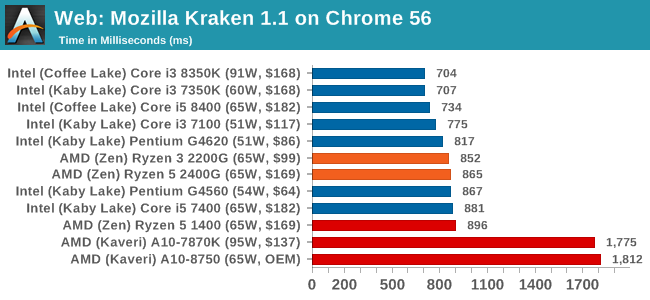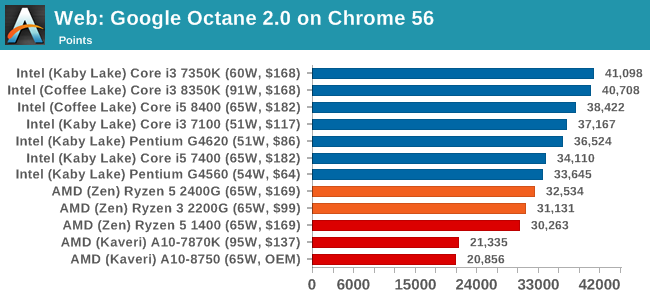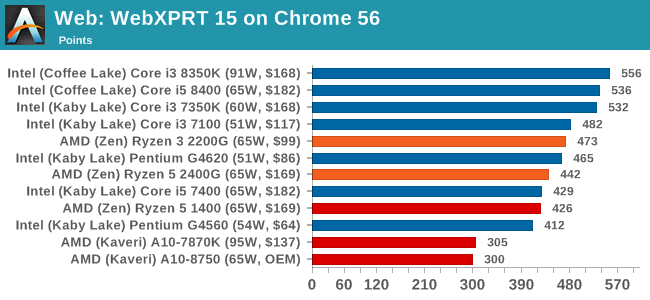Marrying Vega and Zen: The AMD Ryzen 5 2400G Review
by Ian Cutress on February 12, 2018 9:00 AM ESTBenchmarking Performance: CPU Web Tests
One of the issues when running web-based tests is the nature of modern browsers to automatically install updates. This means any sustained period of benchmarking will invariably fall foul of the 'it's updated beyond the state of comparison' rule, especially when browsers will update if you give them half a second to think about it. Despite this, we were able to find a series of commands to create an un-updatable version of Chrome 56 for our 2017 test suite. While this means we might not be on the bleeding edge of the latest browser, it makes the scores between CPUs comparable.
All of our benchmark results can also be found in our benchmark engine, Bench.
Mozilla Kraken 1.1: link
Kraken is a Javascript based benchmark, using the same test harness as SunSpider, but focusing on more stringent real-world use cases and libraries, such as audio processing and image filters. Again, the basic test is looped ten times, and we run the basic test four times.

With the newer high-performance cores, AMD gets a fair crack at benchmarks like Mozilla, where it historically lagged behind with its Bulldozer-family architecture.
Google Octane 2.0: link
Along with Mozilla, as Google is a major browser developer, having peak JS performance is typically a critical asset when comparing against the other OS developers. In the same way that SunSpider is a very early JS benchmark, and Kraken is a bit newer, Octane aims to be more relevant to real workloads, especially in power constrained devices such as smartphones and tablets.

In recent years, Intel has made strides on its Octane performance. So even with cores and threads, and the sizable jump up from Kaveri, AMD is still behind on this test.
WebXPRT 2015: link
While the previous three benchmarks do calculations in the background and represent a score, WebXPRT is designed to be a better interpretation of visual workloads that a professional user might have, such as browser based applications, graphing, image editing, sort/analysis, scientific analysis and financial tools.











177 Comments
View All Comments
Fritzkier - Tuesday, February 13, 2018 - link
Well not really. While they using Pentium G with GT 730 or lower, many uses AMD A-series APU too (since they no need to use low end discrete GPU to be on par)And Ryzen 2200G also priced the same as Pentium G with GT 730 tho. The exception is RAM prices...
watzupken - Tuesday, February 13, 2018 - link
If AMD uses a beefier Vega IGPU, are you willing to pay for it is the question? I feel iGPU will only make sense if the price is low, or if the power consumption is low. Where Intel is using AMD graphics, is likely for a fruity client. Outside of that, you won't see many manufacturers using it because of the cost. For the same amount of money Intel is asking for the chip only, there are many possible configuration with dedicated graphics that you can think of. Also, the supposedly beefier AMD graphics is about as fast as a GTX 1050 class. You are better off buying a GTX 1050Ti.iwod - Tuesday, February 13, 2018 - link
Well unless we could solve the GPU Crypto problem in the near future ( Which we wont ) I think having better Vega GFx combined with CPU is good deal.Gadgety - Monday, February 12, 2018 - link
Will these APUs do HDR UHD 4k Bluray playback (yes I know it's a tiny niche), or is that still Intel only?GreenReaper - Wednesday, February 14, 2018 - link
Probably best to just get an Xbox One S for it. As a bonus you could play a few games on it, too!watzupken - Tuesday, February 13, 2018 - link
I feel the R3 2200G is still a better deal than the R5 2400G. The price gap is too big relative to the difference in performance. And because these chips are over clocking friendly, so despite the R3 being a cut down chip, there could be some performance catchup with some overclocking. Overall, I feel both are great chips especially for some light/ casual gaming. If gaming is the main stay, then there is no substitute for a dedicated graphic solution.serendip - Tuesday, February 13, 2018 - link
The 2200G is a sweet because it offers most of the 2400G's performance at a sub-$100 point. For most business and home desktops, it's more than enough for both CPU and GPU performance. And with discrete GPUs being so hard to get now, good-enough APU graphics will do for the majority of home users. Hopefully AMD can translate all this into actual shipping machines.I'm going to sound like a broken record but AMD could send another boot up Intel's behind by making an Atom competitor. A dual-core Zen with SMT and cut-down Vega graphics would still be enough to blow Atom out of the water.
msroadkill612 - Tuesday, February 13, 2018 - link
Its a pity they dont get hbcc.msroadkill612 - Tuesday, February 13, 2018 - link
Simply put, amd now own the entry level up to most 1080p gaming, and its a daunting jump in cost to improve by much.Its polite and nice of this review to pretend intel has competitive products, and include them for old times sake.
serendip - Tuesday, February 13, 2018 - link
Looks like AMD owns the good-enough category. As I said previously, let's hope this translates into actual machines being shipped, seeing as OEMs previously made some terrible AMD-based systems at the low end.